
Everyday I hear more news about new advances in artificial intelligence from writing essays for school children turning a picture of grandma into an Amazonian warrior princess. It is safe to say that AI and its impact on our lives is here to stay. The City of the Great Machine brings the experience of global AI dominance to the table in a variety of intense and masterful ways.
City of the Great Machine is a 1-4 player game from designer German Tikhomirov and publisher CrowD Games. In this game, humans have set out to create the perfect city, which has led to the creation of the Great Machine. Over time, the Great Machine has encroached on every aspect of human life, and has come up with a master plan to perfect all areas of the cities, including the humans themselves. The humans, however, are not ready to just lay down and let a machine take over their lives. In City of the Great Machine, a small group of heroes must work together to raise discontent among the citizens of the city and incite riots before the Great Machine can see the master plan to completion.
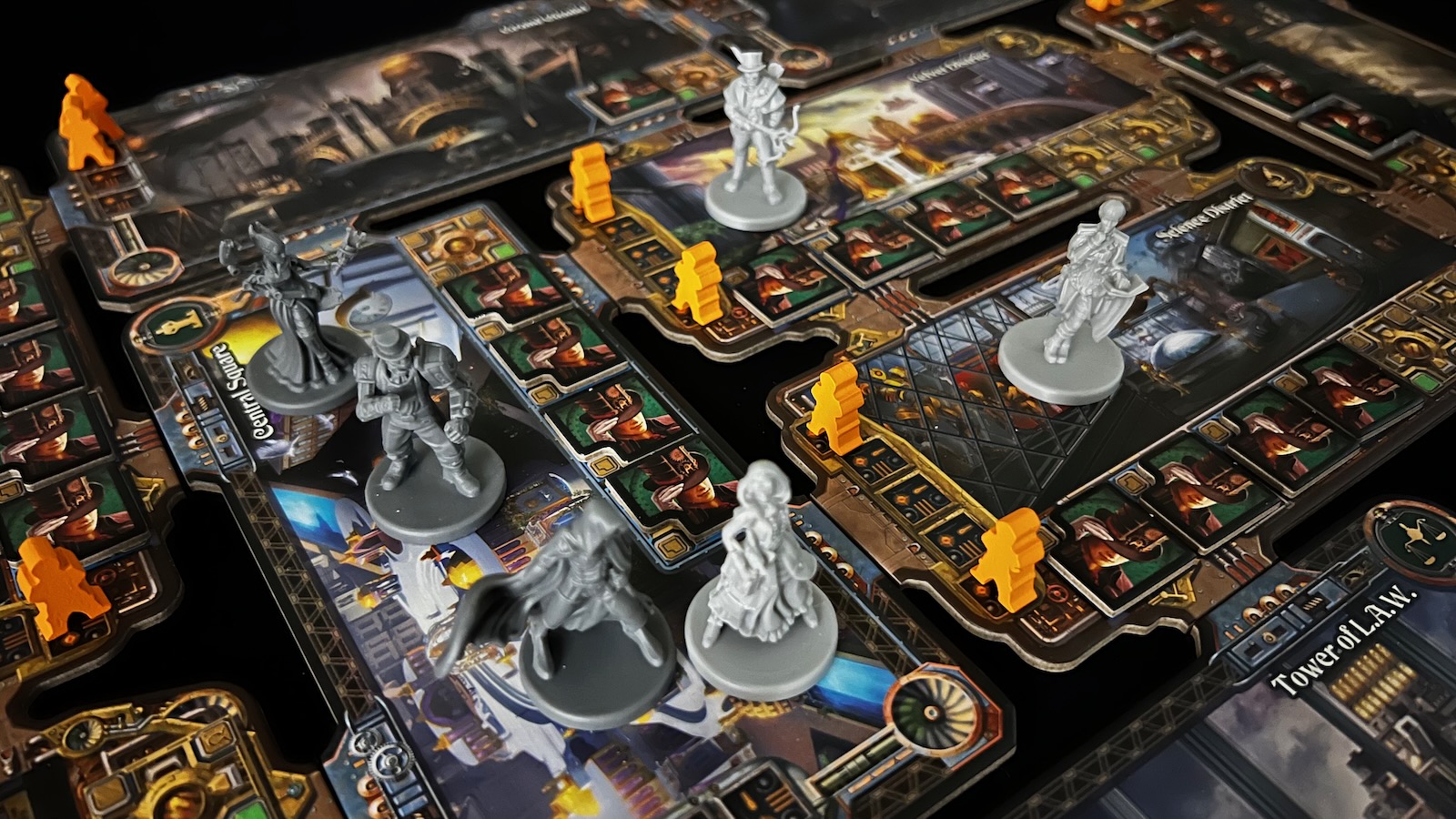
Heroes and servants of the great machine take their places on the modular board.
The game offers a variety of ways to play including a solo and co-op module. In a normal game, one player takes control of the Great Machine, its guards and its three servants. The other one to three players will control a team of three Heroes through cooperation and teamwork. Each hero has a special ability, unique initiative number, and amount of trust (currency) they can carry.. Each round has a series of phases that introduce round conditions, let players plan their strategy, and a variety of different player actions around the modular board.
The playing area consists of a series of minor and major district tiles that you can set up randomly or through a series of prearranged maps in the rulebook. Each district starts with two of the Great Machine’s mechanical guards and a series of unrevealed, face down, citizen tiles. These citizens represent the city’s population with different levels of willingness to join the rebellion and even a few traitors loyal to the Great Machine. Each of the major districts offer special actions to both the Great Machine and the Heroes, with minor districts allowing the Heroes raise the level of discontent. A fun aspect of the board is that either side can take an action in one of the Control Nexus major districts to change it. The district tile must be able to freely slide out of its current position and districts must be connected to at least two other districts before and after the move. This tile movement mechanic can help both sides optimize movement for their team or hinder movement for the other.

The Great Machine measures their master plan progress on the outside wheel and citizen discontent is measured on the inside wheel.
You track progress on a multi layered wheel with two different movable dials. The inner circle measures the overall discontent among the citizenry. Each level activates a new group of citizens to fight alongside the Heroes, but also gives the Great Machine more income at the beginning of each round. If the Heroes can raise discontent to the top of the dial, they will cause a riot and be a third of the way to winning the game. The outer dial represents the Great Machine’s master plan. When the dial reaches twelve, the master plan takes effect and the Great Machine wins immediately.

A new City Event card is revealed at the start of each round.
The beginning of each round flips a city event card that introduces two conditions for the round. The first is an ongoing or end of round condition to follow or task to accomplish assigned to one of the two teams. The bottom half of the card gives a special condition that if met during the round, will advance the master plan for the Great Machine. Players will then get to take income. Heroes gain “trust” tokens based on the number of citizens in their current district and the Great Machine gains “bond” tokens based on the level of the discontent wheel.
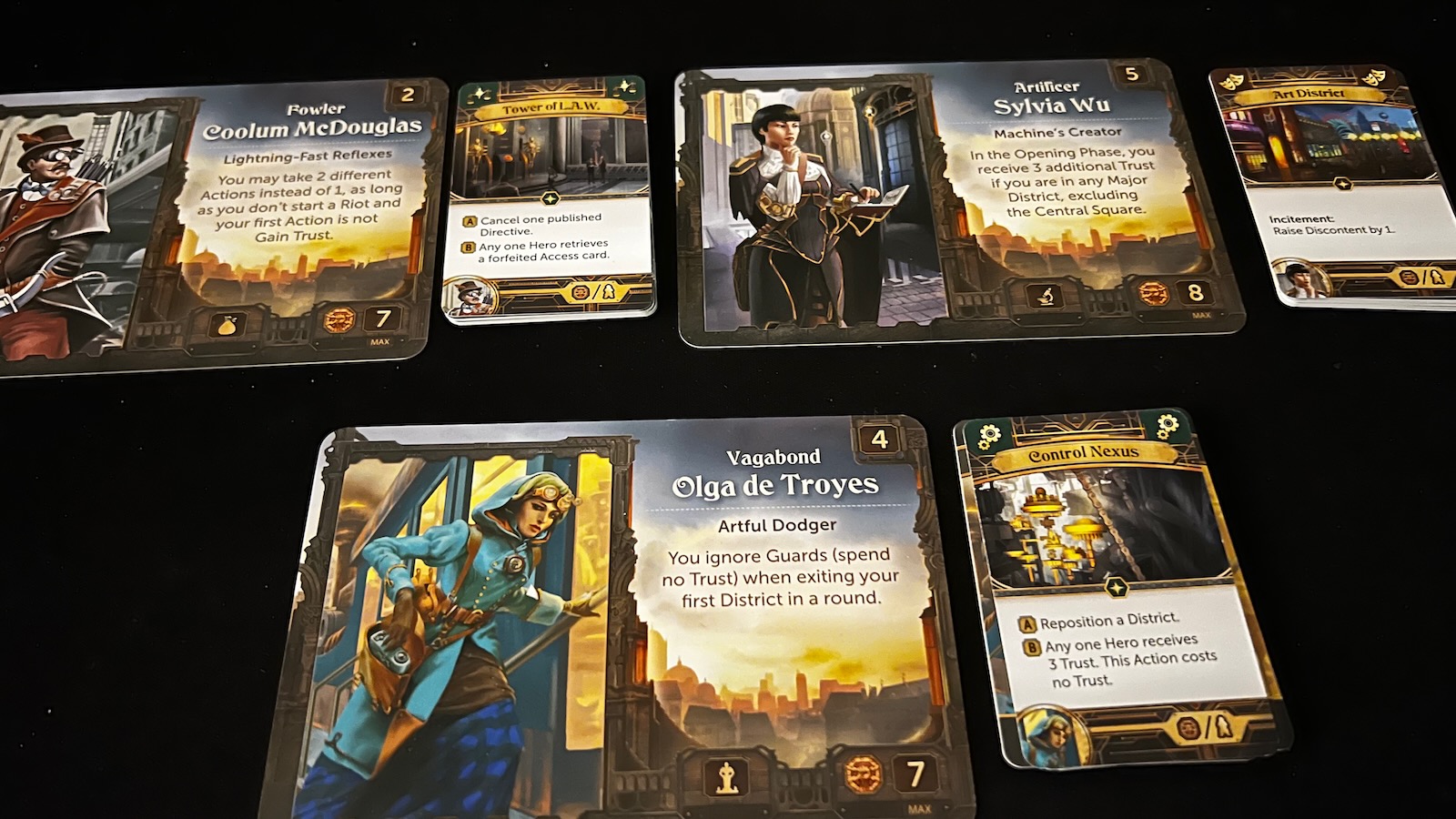
Heroes plan their movement using access cards. Each hero also has a special ability.
The next phase is called the access phase and is one of the most important parts of the game for the Heroes. In this phase, players will decide where they want their characters to go, indicated by playing a face down card representing the location. Hero players will work together to determine where they want to go based on what actions they want to take and what they think the Great Machine might do during their turn. After players have locked in the access cards, they are unable to change them and play shifts to the Great Machine Access phase. One of the hardest rules in the game is that hero players must converse out in the open. This means the Great Machine player gets to hear everything, making it difficult to communicate verbally and making the players resort to pointing and misdirection during planning.
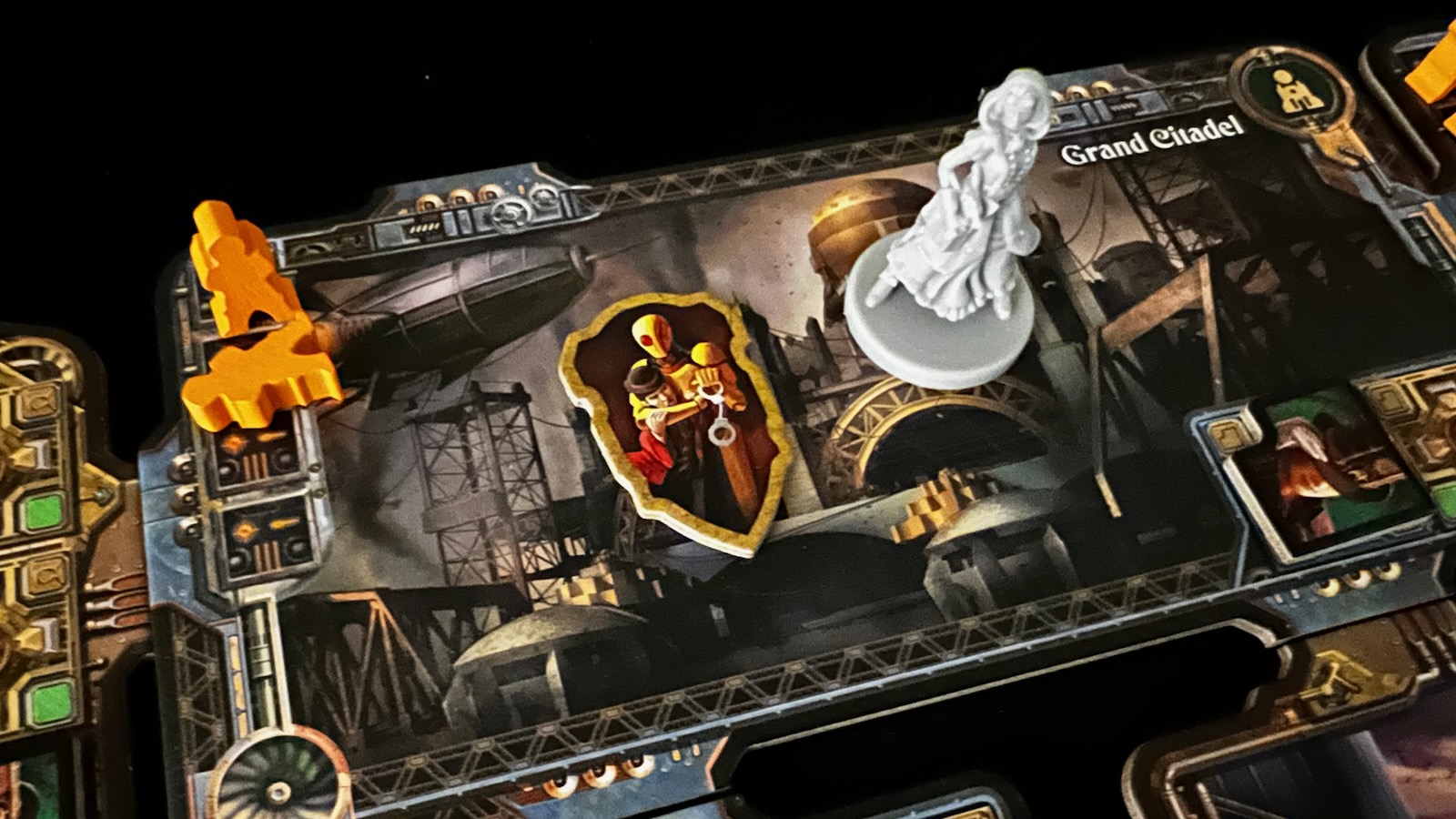
Heroes can attack and damage city guards but can also get caught in raids instigated by servants of the Great Machine.
The Great Machine carries out their actions through their guards and servants, spending bond tokens to move and take actions. The guards make it more difficult for hero players to take actions and can be moved around the board to districts the Great Machine thinks nefarious things are happening. The servants can move around and take actions such as arresting and removing citizen tokens from the board, repairing guards, taking special district actions, and enacting raids. If a hero ends movement in a district with a raid, they are detained and the Great Machine gets to make a choice. The Great Machine may raise the master plan dial by one or end the hero’s turn and take their access card away, effectively blocking the hero from entering the district again, or converting all the hero’s trust into bonds. The other big difference for the Great Machine is the ability to gain and publish directives by taking major district actions. Directives give the Great Machine new abilities or new conditions that the Heroes must follow. When taking their turns, the Great Machine must balance their bonds to try and limit the progress of the Heroes.
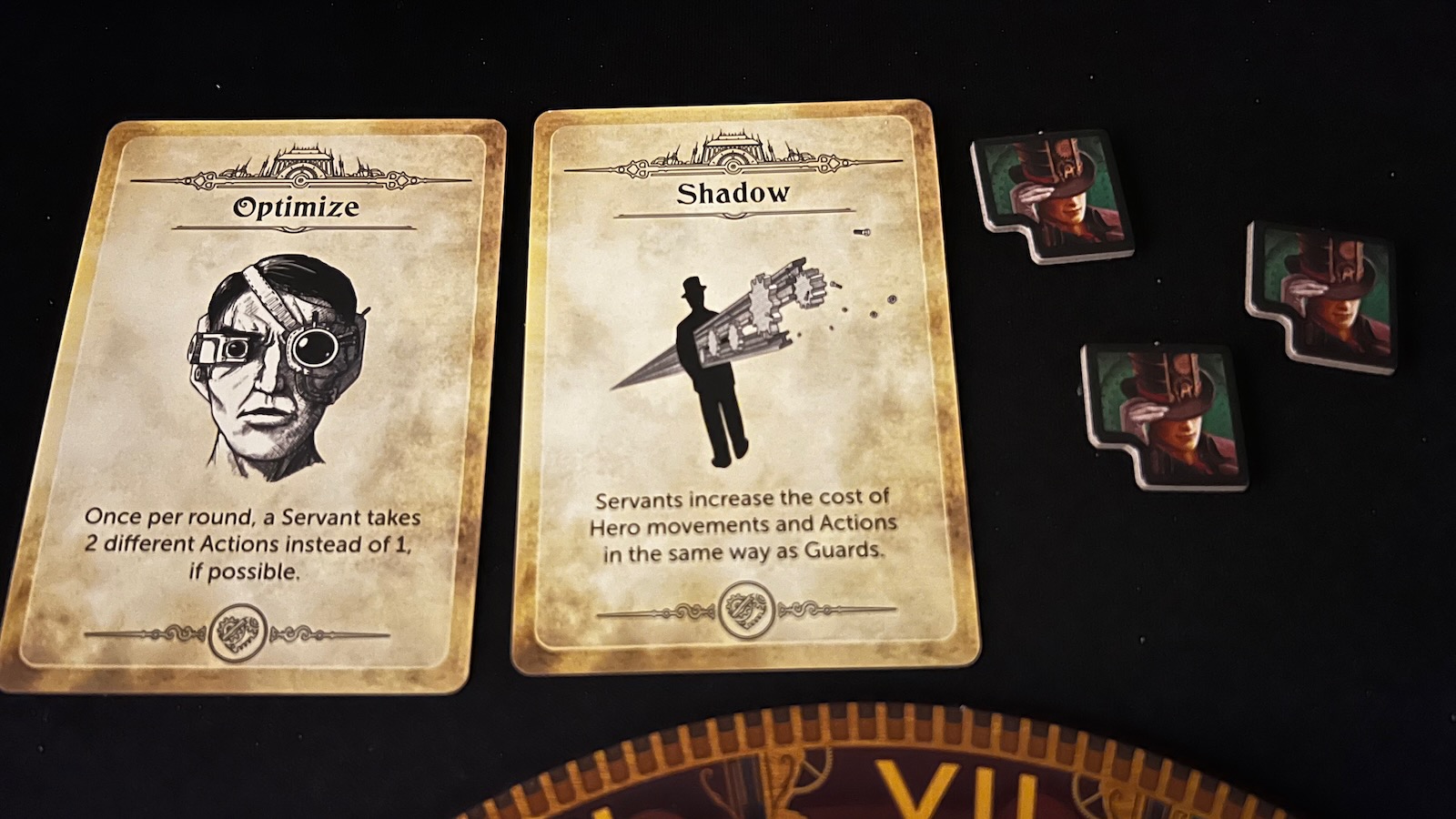
Directive cards can change rules in the game and help the Great Machine. The Great Machine can also kidnap servants.
After the Great Machine phase, the Heroes take their turns in low to high initiative order, which is indicated on each hero’s player card. The first step is always moving, and the Heroes must move to the location on their access card. Heroes spend trust to move based on the number of guards in each district they are leaving. One guard equals one trust. If they can’t pay the cost, then Heroes roll a special dice with a 50-50 chance of being detained. Once at a location, players have a variety of different actions they can take including attacking guards, revealing citizen tiles for the hero team to see, raising discontent, and taking special actions. Some of the special actions unique to the Heroes are rescuing arrested citizen tiles and access cards and taking out the Great Machine’s directives. The main special action is inciting a riot. This is done by paying trust and hoping that the number of citizens actively supporting the cause outnumber the guards in a district. If so, a riot begins and the guards are disabled; if the riot fails, the citizens in the district are arrested and the master plan advances.
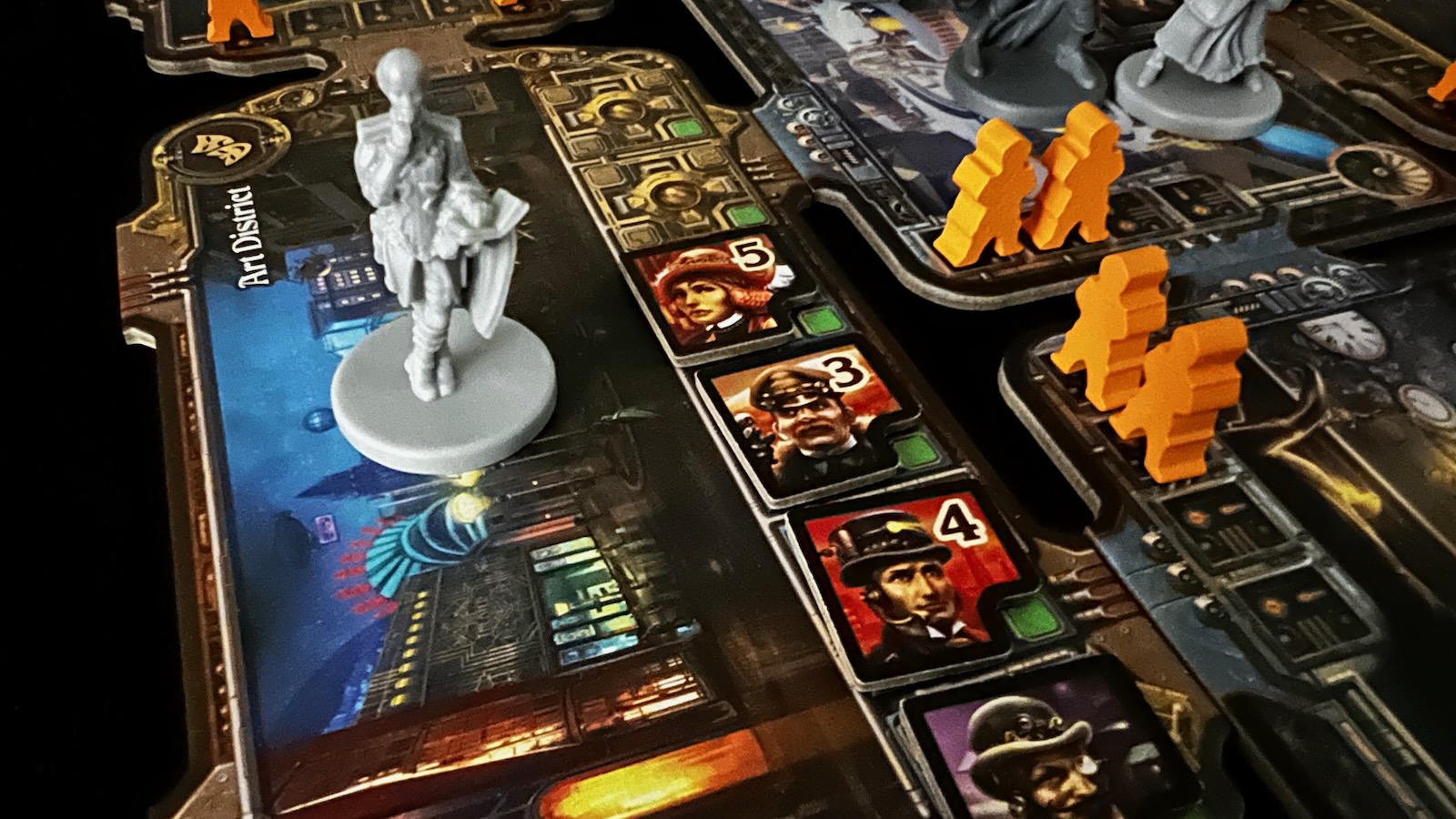
Heroes can start riots in districts using the citizens, but only if the discontent is high enough to activate them.
After the Heroes all take their actions, the players will resolve the text on the active city event card and raise the discontent for each failed raid the Great Machine callously forced upon the citizenry. Then the next round will begin with a new City Event and progress through the phases until one of the win conditions is met.
One of the best features is the Solo and Cooperative mode, which is not something you will hear me say often. The S&C mode is run by an AI Great Machine module, which is slightly meta when you think of an AI for the fictional AI from the game…but I digress. In this module, 1-3 players can work together to defeat the Great Machine as a team. Most of the gameplay is the same, but the servants are controlled through an automated deck and each of the servants has an action priority list when reaching a new district. The module also includes unique city events and directives. The best thing about the module is the inclusion of a set of scenarios. Each scenario gives the Heroes a unique win condition and tells a campaign-like story for players to work through. To be honest, this is one of the best solo/cooperative modules I’ve seen in a game. The actions for the AI are not overly different from the real game and the directions are easy to learn. The game also includes four missions for players to work through once they have grasped the rules of the game. These missions guide the tasks the player(s) must complete and can even be mixed and matched for greater replayability.

The Solo and Cooperative mode give the servants different strategies to combat the heroes.
The components of the game are outstanding. Each hero and servant comes with its own miniature and the color tint makes it easier to differentiate between the two player sides. The cardboard used throughout the game is thick and high quality. The artwork used on the cards and board is a steampunk lover’s dream with great detail and color palettes. The cards are also high quality, but I am never a fan of an abundance of small cards. The player access cards are small and difficult to read and could have easily been made bigger and differentiated through artwork. Some of the best design features are found in the rulebook and reference guide. The rule book is laid out sequentially starting with set-up and then detailed descriptions of each phase of the game. Each phase comes with full color and well explained examples of actions taken and even includes some strategies for new players to consider. The reference guide explains city events, directives, and hero abilities and strategies in depth and outlines the solo and cooperative modules with the same detail as the main game. Combined with player aide cards, these two books made learning the game easy and referencing rules throughout gameplay a breeze.
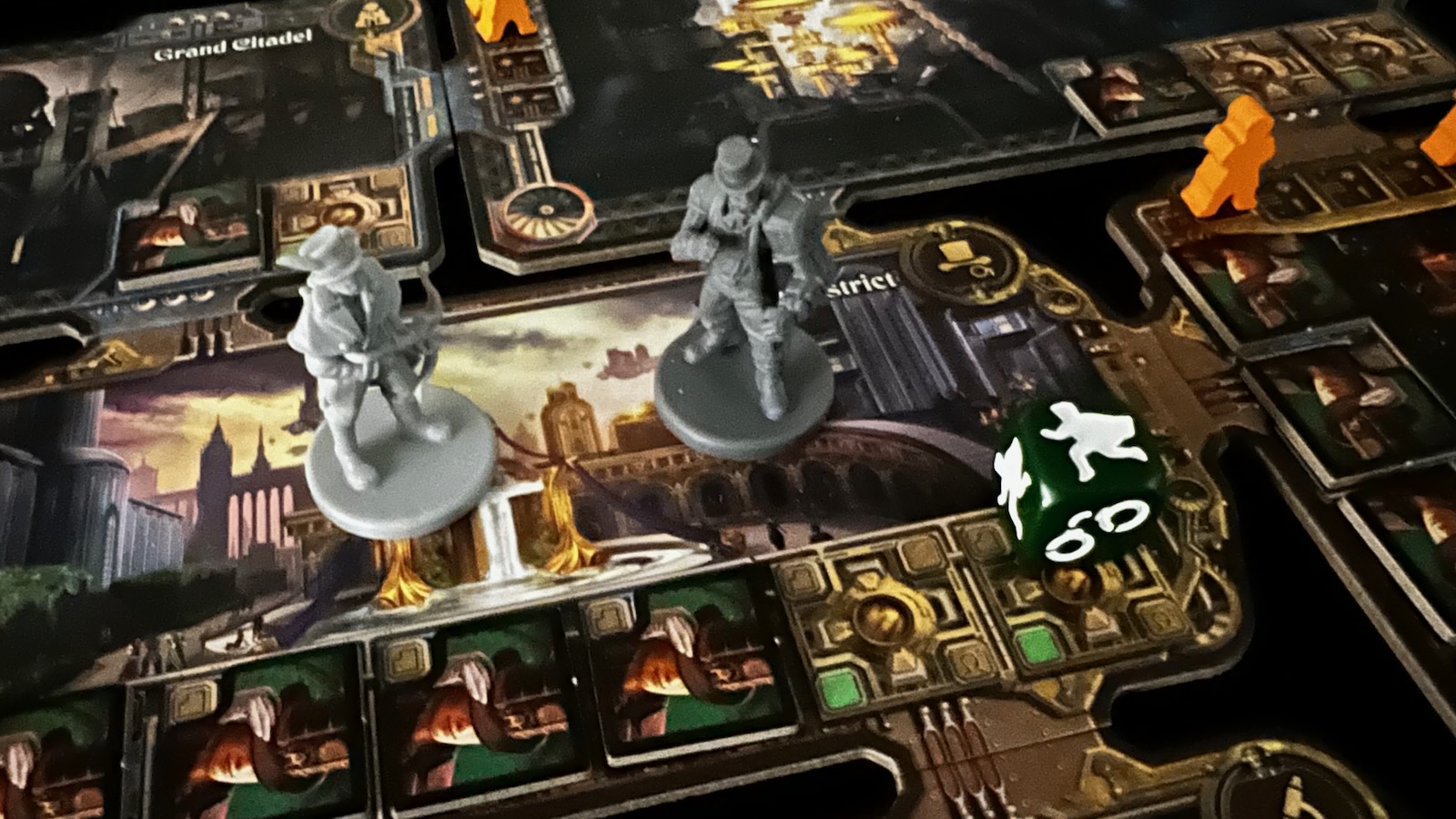
Players caught in a raid or not having enough trust to move through a district must roll the evade die to try and escape.
The gameplay of City of Great Machine is a lot of fun and brings tension from turn one. Some hidden movement games take time to develop action and friction, but it seems like every turn is valuable and important in this game. While the full four player count brought a lot of energy to the table, it was a lot harder for the hero players to come to a decision on how to proceed, and added more time to the gameplay. Communication is also harder with a three person team, with plenty of information slipping out to the Great Machine with an overzealous player. The make-up of the hero team and how well they cooperated definitely factored into the overall experience. The best experiences with the game were the two player games. The one v. one games were some of the most intense. The hero player is able to make decisions without the noise of other players and the game moves much faster. The cooperative two player game was also a-lot of fun because the Great Machine player is run by a deck of cards and deliberation can take as long and be as loud as you want without the machine hearing. One of the downfalls of any hidden movement game is the guessing element. In some plays, if you have players that just make the wrong guesses, things can go south quickly for one side or the other. You really have to pay attention and make observations, but at the same time some turns are going to be straight luck. When the machine guesses wrong on a raid, it will raise discontent and guessing wrong for the Heroes can lead to loss of resources and restricted turns. While this is definitely an element of what makes the game fun, guess wrong too much and your game can go up in flames fast.
City of the Great Machine
Excellent
A great hidden movement one vs. many game that shines in its versatility of play modes and player counts. Tension and excitement from turn one.
Pros
- Tension filled gameplay from turn one
- Solid Player vs. Player, Cooperative, and Solo experiences included
- Well designed components and reference materials
Cons
- Player vs. Player can get bogged down at higher player counts
- Some games can be lopsided when players guess wrong
